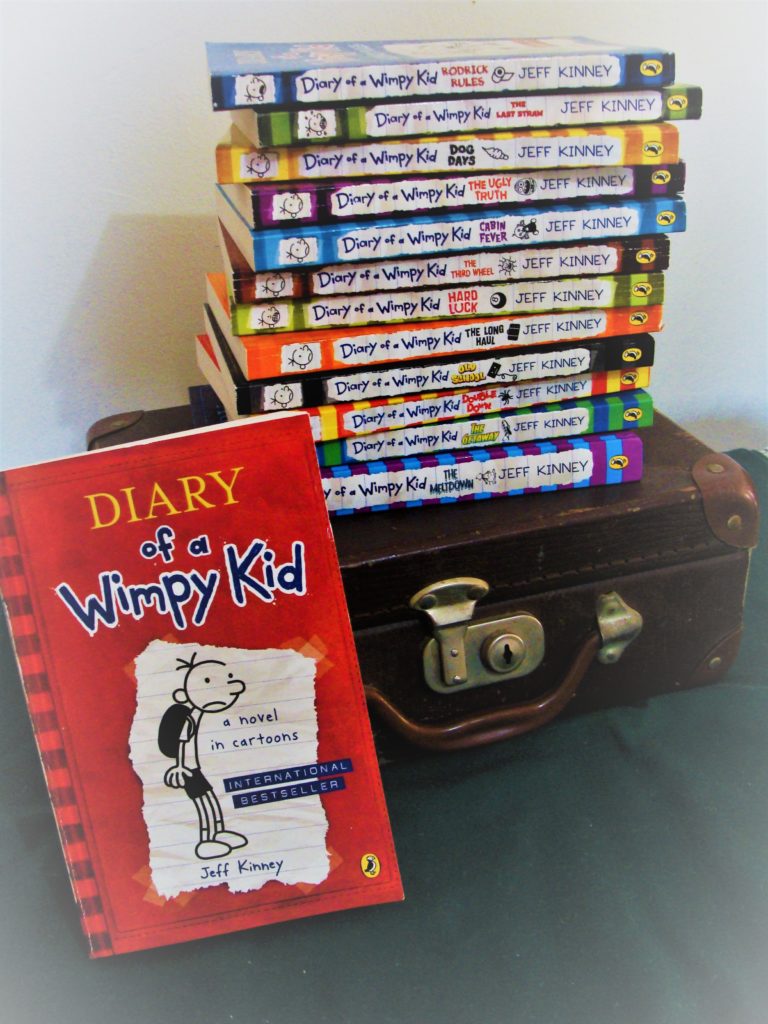
Have you heard of the Diary of a Wimpy Kid series? If you have ever entered a bookstore or know anybody with children, you probably have! This is a series that has made quite a name for itself and has built a somewhat notorious reputation of winning reluctant readers over with its many cartoon-style illustrations and witty sense of humour. When one also brings up the atypical main character and the apparent lack of spelled-out “lessons,” it is to be expected that there will be those who are less enthusiastic about these books. If you are a concerned parent wondering whether your children should be reading Diary of a Wimpy Kid, or if you are simply curious to know more, this blog post is for you!
Diary of a Wimpy Kid books are created with a combination of diary entries and cartoon-style illustrations and are written and illustrated by Jeff Kinney. The series started off in 2004 as a story published, in installments, on the educational game- and reading website Funbrain (to read these original installments on their site, follow this link). After its online debut, Diary of a Wimpy Kid steadily grew in popularity and the first book (an abridged version of the online chronicles) was published in 2007. It was followed by twelve more, the thirteenth having been released in October 2018. Books from the Diary of a Wimpy Kid series have already been translated into 58 languages. Four movies, based on the books, have also been made.

The story features the main character, Greg Heffley, who is in middle school. For the South Africans who are unsure of what “middle school” is, it is a dedicated school for grades six to eight, found in most U.S. states. Naturally, that is a confusing period in the lives of children – they do a lot of growing up in those years and belonging to a “group” becomes increasingly important. However, Greg does not seem to be bothered so much by peer pressures and pimples as he is bothered with how tedious and dreary life can be. On top of that, he has got an unusually dry sense of humour which his family and friends do not share. And with all the absurd things that happen in his life, who can blame him for being somewhat of a skeptic?

I have to admit, skeptical was what I was too when I first encountered this series. Online reviews, mostly written by concerned, moral mothers who read through segments of the first book, did not help much. However, kids seem to absolutely adore these books and even children who are not regular or strong readers devour them. So, I decided to give this seemingly controversial series a fair try and share my findings.
Here are ten things you should know about the Diary of a Wimpy Kid series:
1. Readers of all ages seem to enjoy these books.
The Diary of a Wimpy Kid series is mostly targeted at boys of about nine to fourteen years. However, girls seem to enjoy and read these just as much and even older children and adults grow to love these characters and stories. I have read through the entire series myself (at the age of 34) and, although it was for “research” purposes, I can honestly say that I enjoyed it and have giggled my way through more pages than I can remember.
2. The numerous illustrations are unlikely to encourage “lazy” reading.
Every book in this series has an average of 150 illustrations and, yes, that is a LOT. However, these illustrations do not “dumb down” what is being said, neither are they unnecessary to the story. On the contrary, the illustrations are essential to the narrative and actually contain portions of the story line. If only the text is read without seeing the illustrations, the story would no longer make sense. Often, the content contained in the pictures are not overly obvious and one would have to pay attention to the details taking place in the pictured scenes. Further, plenty of humour and wit are comprised in these drawings. So, do not fear that these multitudes of illustrations will lead to lazy reading. Instead, it will improve young readers’ perceptiveness – not to mention their sense of humour!
3. Diary of a Wimpy Kid is not your typical children’s story.
In a story written for children, one would expect a likeable main character, or at least one that grows into a likeable person throughout the story. Jeff Kinney was not concerned with creating a character you could like. Rather, he created one that reflects real life, albeit life as experienced by a cynical, miserable middle school kid with a flawed family life.
4. These books contain a dry dose of humour.
Besides the witty, light-heartedness, there is a mood of dry humour that runs through the stories and that kids seem to really love – even the less cynical ones. The drawings aid this humour stunningly and even older readers will find themselves laughing at all the shenanigans of the Wimpy Kid characters. I certainly did!
5. Greg has a somewhat unusual approach towards life.
Greg is “encouraged” by his mother to keep a journal (not a diary!) in which he can express his feelings. Although he would not admit it, Greg actually enjoys keeping record of his life and expresses himself not only through writing, but drawing too. And, Greg has quite a lot to express. For a boy his age (not stated anywhere, but probably eleven or twelve), he is surprisingly cynical and unenthusiastic about life. Perhaps that is the reason why his mother got him started on the diary in the first place, as this is clearly a troubled and frustrated little boy. With an older and a much younger brother – neither of whom he gets along with – his family life is often a struggle. Despite being quite intelligent, he does not really find anything at school exciting or interesting, and he has a hard time making friends. In fact, he does not really have any interest in making friends, although he is quite aware that he needs them – therefore, his awkward but faithful friendship to good-natured Rowley.
The concerns about this story are that Greg is lazy, negative, doesn’t seem to really like his own best friend and never tries to do his best in any way. It usually feels “wrong” to read stories like this and, by nature, one is even more worried when this is found in children’s literature. Won’t such a protagonist have a negative effect on young readers who are still shaping their outlooks on life?
I felt that the author’s approach here was different than the norm and he aimed at making the minority-kids realise that they are not alone, rather than showing them what the idealistic middle school life should look like. Cynical and less positive children also need to know that others are faced with the same challenges they are. Let’s be honest, not everybody can be as naïve and easy as Rowley and not everybody loves sports or sleepovers. As adults, we often tell ourselves that it is okay not to be like the crowd, but shouldn’t children be able to hear this as well?
Greg might not be the greatest role model, but he does succeed in making children feel that they are not alone in what they deal with. Whether they are finding it difficult to make new friends, are worrying that their family gatherings might turn into disasters or are scared to get into the car when their older brothers are driving – it might be encouraging for them to know that other children deal with similar scenarios and that it helps to occasionally try and see the humour in these situations!

6. Greg does not always learn from his mistakes, but that doesn’t mean the reader won’t.
Although Greg does grow in some ways and occasionally adds up to his mistakes, the author did not make character growth and “learning from his mistakes” a requirement for writing his character’s adventures. Rather, he paints the actions and consequences clearly and leaves the reader to make the logical conclusions. It is somewhat refreshing to find an author who does not think that kids need to see a protagonist learn from his mistakes in order to catch the “lesson,” but rather shows the readers that he has faith in them to learn the lesson themselves from watching the character’s mistakes. Also, there is a striking absence of a “bad guy” character, as, let’s be honest, the real challenges in life are often shrewdly camouflaged as homework assignments, family gatherings, your little toddler brother’s tantrums and making your own dinner when Mom is out late.
Also, Greg, does have some credit due to him. He is far from an insensitive or reckless child. He feels sad when something bad happens to one of his parents, he tries his utmost best not to hurt his grandpa’s feelings and, although he doesn’t necessarily enjoy it, is patient and responsible when looking after his little brother.
7. Greg is comfortable with who he is.
True, Greg could benefit from working a little harder and striving a little higher, but he is content with who he is; something that children can benefit from learning early on in life. Despite some doubtful motives from time to time, he does not fall victim to peer pressure or try to be anybody but himself. Whoever you are and whatever personality you have, the world needs one of you!

8. If your child turns out to be a big Diary of a Wimpy Kid fan, there are several other recreational items and publications that you can put to good use:
- The Wimpy Kid Do-It-Yourself Book. Despite the stunning amount of details contained in Kinney’s drawings, they still possess a charming simplicity and are a great way to inspire young artists. This little book gives the reader plenty of fun drawing prompts and ideas. Additionally, drawing guidelines are available on the Diary of a Wimpy Kid website, as well as the Diary of a Wimpy Kid YouTube Channel.
- Diary of a Wimpy Kid MAD LIBS. This book contains great vocabulary exercises for aspiring young writers and is presented in the form of a hilarious game where random words, chosen according to word types, work together to tell a story. These exercises can be quite useful in a classroom setup!
- Board games. If you think you would love to gain some fun family time from this series, these board games are the ideal choice. Diary of a Wimpy Kid: The Cheese Touch Game was released in 2010 and is a straight-forward game containing a variety of amusing questions for players to answer. Diary of a Wimpy Kid 10 Second Challenge was released in 2014 and is slightly more elaborate (but still easy), containing many entertaining activities and challenges. Both these games were illustrated by Kinney himself, and is suitable for up to six players, with six game markers that look like your favourite Wimpy Kid characters.
9. For some extra peace of mind, there are a vast amount of resources available to supplement the Diary of a Wimpy Kid series.
Whether you are a teacher or a concerned parent and still feels somewhat uneasy about your children reading Diary of a Wimpy Kid or suspect that the subtle “lessons” might be lost on them, do not fear. The Diary of a Wimpy Kid website has a wealth of resources available in the form of teacher guides and activity packs. These can be downloaded for free and are ideal to use in a classroom, library or other reading group setup. Even parents can use these with their children at home; they can be printed from a home computer and should keep any Wimpy Kid fan engrossed for hours.
The resources available on the American and British websites are similar, but not identical, so it is worth checking out both to see what suits your needs: for the American site follow this link and for the British site follow this link. I especially like the fact that the British site has a teacher’s guide for each individual book in the series and can therefore be extremely helpful in classrooms for encouraging discussions.
10. The Wimpy Kid stories are definitely not dull or predictable.
The stories and characters in these books are full of surprises and will keep readers constantly intrigued. To give you a taste of what you can expect, here are some interesting tidbits about the Wimpy Kid characters:
- Greg wears contact lenses and is pretty helpless without them.
- Greg claims to remember things that happened while he was still in his mother’s womb. According to him, his parents’ soppy excitement about his kicking (as a response to their kisses) disturbed his sleeping pattern and made him decide to arrive three weeks earlier than expected. His birthday is in June, although the exact date is never mentioned. He weighed 5 pounds and 7 ounces. For the first few months of his life, he slept in a drawer, because his parents only owned one crib, which was still in use by his older brother, Rodrick.

- Greg has a younger brother, Manny, who is probably nine or ten years younger than him. Manny, not unlike Greg, has poor social and physical skills, but has by the age of three already mastered the art of changing the parental control settings on the television, changing Greg’s online gaming passwords (and selling his inventory) and selectively turning off trip switches on the electricity box. Later on in the series, Manny becomes even more mysterious when he seems to hardly ever talk to anyone, but starts speaking fluent Spanish out of the blue.
- Greg suffers from a mild claustrophobia and once had to be rescued from a children’s play tunnel at a restaurant after he climbed in to rescue Manny, who (yes, you guessed it) became claustrophobic and couldn’t climb out.
- In The Long Haul, Greg claims to have a photographic memory. However, he failed to support his claim with sufficient proof.
- Once, Greg went for more than five months without having any of his laundry washed. This happened after his mother decided to teach him a lesson for not using a laundry basket and stopped doing his laundry. The result: Greg resorted to reusing dirty laundry and scouring for items never worn before.

- Greg’s mom occasionally writes a parenting column in one of the local newspapers. She is an avid reader of the magazine Family Frolic, which (to the despair of her family) is the inspiration for many of her fervent family activities.
- Thanks to Greg’s encouraging mother, he had a few moments of fame in his past. A few years before starting middle school, Greg’s photo appeared on the cover of a medical book called Your Child and Constipation after his mom thought it would be a good idea to take him to a modelling audition. When he was in the third grade, he wrote a poem which his mom sent to the National Poetry Council. They published it in their Poetry Anthology which they had to buy at a whopping $80 a copy.
See Jeff Kinney in South Africa
Some good news for the admirers of Jeff Kinney residing in Cape Town and Johannesburg: he will be visiting South Africa from the 5th to the 7th of March 2019 as part of his The Meltdown world tour. Click here to buy tickets for the events and see Jeff Kinney in action!
